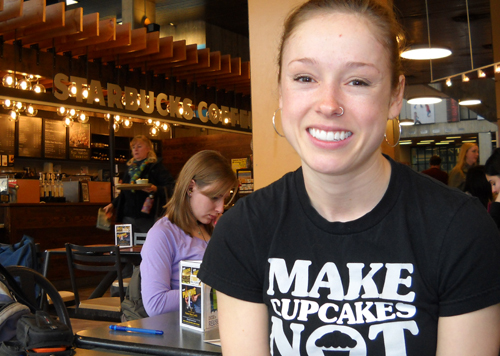
Seventeen years. That’s how long it takes on average for health research to make its way into policy, says Mary Anne Smith. Speeding up that process to improve Canadians’ health is the goal of her doctoral research in U of G’s Department of Food Science.
A registered dietitian and self-described “military brat,” Smith has studied players and processes in food and nutrition to help bridge research and policy in less time. She looked at a federal bill introduced in 2003 that had called for nutritional labelling on restaurant menus. Although that bill never became law, she says it made a good test case for understanding how information flows among numerous groups before it turns into policy.
“As it turns out, we have a pretty poor understanding of how information moves from researcher to policy-makers,” says Smith, who works with food science professor Rickey Yada. “Without a good handle on how this process currently works, we’re unlikely to find an evidence-based means of speeding this process up.”
She collected numerous documents related to Bill C-398 and then analyzed the information for key messages and patterns. It turned out that the bill involved 31 stakeholder groups, 22 target audiences and 35 different modes of communication. Stakeholders used various approaches. Food companies wrote letters to politicians to point out problems with the bill. Consumer public interest groups used online documents to tell the media about health threats.
Smith had planned to cover a number of pieces of legislation but ended up finding enough fodder in the single bill. She hopes her work might provide ideas for groups to work together more closely. That would involve breaking down barriers between scientists typically focused on research and politicians and policy-makers attuned to public sentiment.
She says bridging research-policy gaps is still a relatively new field – new enough that different terms are used to describe it, including “knowledge translation.”
Earlier, Smith completed a biology degree at Wilfrid Laurier University. At Guelph, she finished a degree in applied human nutrition in 2008 and, a year later, a master’s degree with now-retired professor Judy Sheeshka, Family Relations and Applied Nutrition.
“I’ve always been interested in food and health,” says Smith. A friend in high school had an eating disorder. “That was influential on how I saw food and the role it played in people’s lives.”
During her master’s degree, Smith learned more about the wider environmental issues involving health and nutrition. Consider people discharged from hospitals and other health-care institutions, she says. “You send them back to the environment that made them sick in the first place. You have to change the food environment so they don’t get sick to begin with. That got me looking at policy issues.”
She will finish her PhD this summer and hopes to land work that will help her translate research for users, perhaps for groups such as the World Health Organization or the United Nations. A finalist in U of G’s three-minute thesis competition, she represented the University and discussed her research in the province-wide contest held at Queen’s University in April.
Married to Ryan Smith, B.Sc. ’09, Mary Anne grew up in Europe, Canada and the United States. She went to high school in Belgium before her father’s new posting brought the family back to Canada. He’s now involved in Canadian international affairs policy.
Referring to her student years in Guelph, she says, “This is the longest place I’ve ever lived in my life.”
She reads numerous food and nutrition resources from blogs such as Dr. Yoni Freedhoff’s “Weighty Matters” to Brian Wansink’s “Mindless Eating.”
She was a dietitian at Guelph’s Health and Performance Centre for a couple of years. “I have first-hand experience of how hard it is for people to make sense of all that information. Even nutrition students struggle.”
Her eating tips? Stick to single-ingredient foods and make meals as colourful as possible. “I try to eat as I should 80 per cent of the time and what I like 20 per cent of the time.” Her guilty pleasure? Doughnuts.
At gatherings, she says, “I don’t tell people I’m a registered dietitian. They hide their plates.”